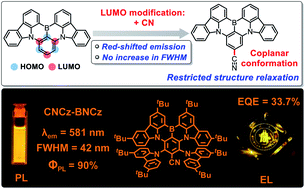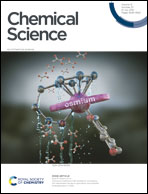Molecular design of thermally activated delayed fluorescent emitters for narrowband orange–red OLEDs boosted by a cyano-functionalization strategy†
Abstract
The establishment of a simple molecular design strategy to realize red-shifted emission while maintaining good color purity for multi-resonance induced thermally activated delayed fluorescent (MR-TADF) materials remains an appealing yet challenging task. Herein, we demonstrate that the attachment of a cyano (CN) functionality at the lowest unoccupied molecular orbital location of the MR-TADF skeleton can promote attractive red-shifted emission due to the exceptional electron-withdrawing capacity of the CN group, which represents the first example of orange–red MR-TADF emitters. Meanwhile, the linear CN group adopts a coplanar conformation with the MR-framework to restrict structure relaxation associated with rotation, which is beneficial to maintain a small full-width at half-maximum and thus a good color purity. The CNCz-BNCz-based OLED device, which utilizes a TADF sensitized mechanism to accelerate the up-conversion process of triplet excitons in the emitting layer, exhibits an outstanding external quantum efficiency (EQE) as high as 33.7%, representing the state-of-the-art performance for orange–red TADF-OLEDs.

- This article is part of the themed collection: Materials & Energy in Chemical Science - most popular articles 2021


 Please wait while we load your content...
Please wait while we load your content...